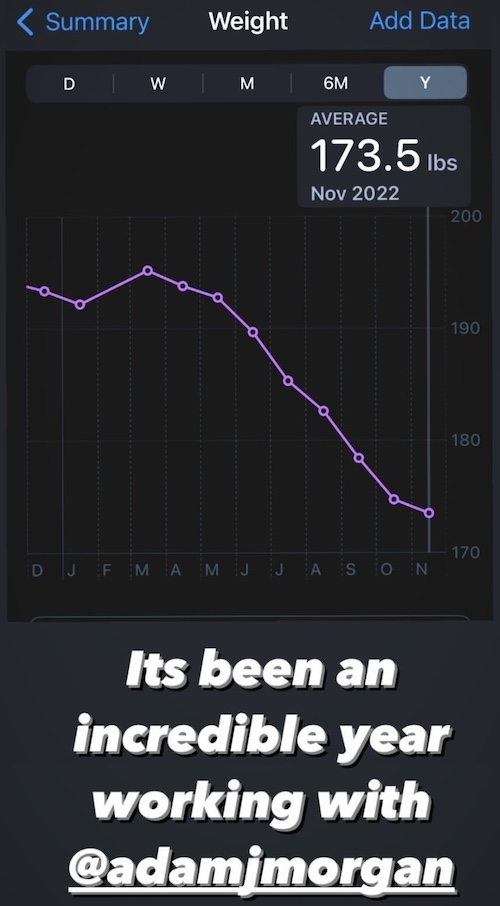Eat More. Lose Weight?
This is how my coaching clients eat more food and lose weight at the same time.


Cutting weight, specifically body fat, is something I’ve previously done with great success.

In this blog post I am going to cover everything involved in my current weight cut protocol to help you get similar results.
Whenever I get as lean as I am in that picture, I start getting a lot of questions. Random people in gyms will just stop me for a quick Q&A session.
The overwhelming majority of people focus on these two things:
If that’s you, I am about to change your entire approach to weight loss forever.
What you need to focus on instead is your diet.
The obvious question now is, “What does a focus on your diet look like?”
It all comes down to calorie balance. I’ll use myself as an example.
To start, I use a TDEE calculator to give me a rough approximation of how many calories I burn in a day (excluding workouts).
With my age, weight, height, and activity levels that puts me around 2,500 calories per day for maintenence.
In other words, if I eat 2,500 calories a day my weight should stay the same (with minor fluctuations).
But if I were to go below 2,500 calories a day my body is now burning more calories than it’s consuming which would put me in a caloric deficit.
This is where the fat burning magic happens.
Now you know what a caloric deficit is. The question now is, “How do we get there?”
There a countless strategies you can use to get into a caloric deficit.
Here’s a few along with a quick description of how they work.
I want to be perfectly clear that any of these dieting approaches will get you results if you do it correctly.
It’s best to view these on a spectrum ranging from “intuition-driven” to “data-driven”.
| Intuition-driven | Intution (ish) | Data-driven (ish) | Data-driven |
|---|---|---|---|
| Portion Control | Low Carb | Intermittent Fasting | Calorie Counting |
| Low Fat | |||
| Low Protein |
If you start dieting with an intuition-driven approach and struggle to see results, consider trying a more data-driven approach.
Similarly if you start with a data-driven approach and quickly internalize how much you should be eating a day, you can switch to a more intuition-driven approach.
Odds are you aren’t going to get this right on your first try especially if it’s your first time dieting. Be patient and be willing to experiment to find what works for you.
I am currently doing a hybrid of Calorie Counting and Intermittent Fasting. I track what I eat (~500 calorie deficit) and limit myself to 2 meals a day starting with lunch. I train fasted in the morning and aim to consume roughly 1g per pound of bodyweight in protein a day.
Another consideration when determing your dieting strategy is how aggresive you want to be with your weight loss.
It should go without saying at this point but the more calories you cut, the faster you will see results. The downside of course is you’re eating less food which is more likely to make you hungry, frustrated, and prone to binging.
The other approach would be less aggressive calorie cutting with more time needed until you see results.
It’s a balancing act and similar to your dieting strategy, you need to pick the caloric deficit that you’re most likely to sustain over a long period of time.
My general recommendation is to start by cutting around 250 calories a day. Experiment with that for 2-3 weeks and readjust as needed.
I’m currently taking a more aggressive approach so I’m cutting around 500-700 calories a day.
Once you get yourself into a caloric deficit and the weight starts to drop from the scale, I would recommend taking a break every 4-6 weeks to help avoid burnout and to give your body a break.
Do not use this break as an excuse to binge eat and go crazy. That’s not what this break is about.
Instead a dieting break is about getting out of a caloric deficit and back into your maintenance zone.
Do this for 1-2 weeks and then get back to your caloric deficit using whatever dieting strategy you chose earlier.
If a caloric deficit is what gets our body to burn fat then how much you eat is more important than what you eat.
There are no magic super foods or herbal teas that are going to speed up this process. But there are some general recommendations I can give to make what you eat more likely to directly affect how much you eat.
This is very important because if you eat real food rather than processed or fast foods, you can literally eat more food while consuming fewer calories.
Here’s a high-level list of foods I would recommend using as your guide the next time you go grocery shopping.
| Protein | Carbs | Fats |
|---|---|---|
| Beef | Rice | Eggs |
| Chicken | Potatoes | Avocado |
| Fish | Sweet potatoes | Milk |
| Eggs | Pasta | Nuts |
| Greek yogurt | Oats | Nut butter |
| Cottage cheese | Fruit | Oils |
| Protein powder/bars | Non-starchy vegetables | Salmon |
In this post I’ve primarily focused on diet since that’s the biggest factor contributing to excess body fat.
But rather than focus entirely on diet, we can address our calorie balance from another angle as well.
How many calories you burn rather than how much you consume.
Of course I could hop on a treadmill or bike and start doing interval sprints.
Technically, that would work but there are downsides.
If that’s your cup of tea, go for it.
But why not address the “calories out” side with a more enjoyable and less intense form of cardio?
My current cardio protocol is at least 10k steps a day. On a treadmill it’s at a 10 degree incline at 3.3 - 4.0mph.
If possible, I try to do this outside but it’s obviously more difficult to do this in the winter. For now, I simply hop on a treadmill and walk for 30-45 minutes.
But I’ll be honest. Sometimes walking on a treadmill is boring (even with a podcast!).
On days like that I’ll do 20-30 minutes of jump rope instead. It’s fun, meditative, and learning new tricks keeps it interesting.
New skill unlocked!
— Adam Morgan (@atommorgan) January 8, 2023
Side swing crossover on both sides. I even chained a few reps back to back.
Double unders still need some work lol. pic.twitter.com/f8GGWiqMkO
I hope this blog post helped clear a few things up for you and your weight loss journey!
If you have any questions feel free to follow and send me a DM on Instagram.
That’s exactly what one of my clients, Eric, was able to achieve through 1-on-1 coaching with his personalized nutrition plan.

Eric did all of this using the same protocol outlined in this blog post, customized specifically to him to guarantee results.
After some trial and error we settled on a hybrid “Portion Control/Intermittent Fasting” approach.
This allowed Eric to continue eating the foods he enjoyed while watching the scale continue to drop, week after week.
Are you ready to get results like Eric?
Book an exploratory call with me today to get started on your personalized Fat Burning Protocol.